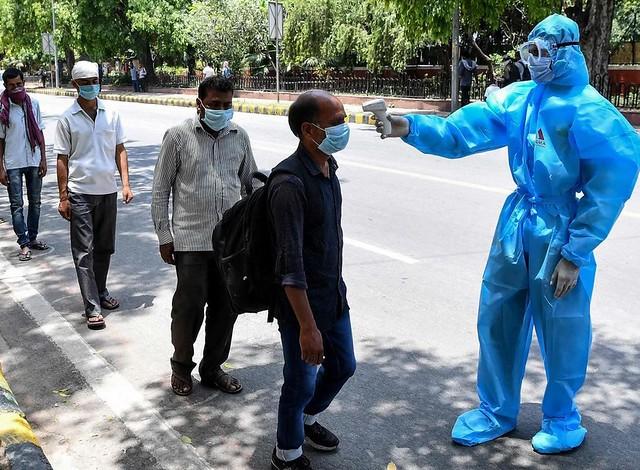India's COVID-19 cases soared even higher today, as the world's second most populous nation came closer to edging out Brazil as the second worst-hit country.
In another development, the head of the World Health Organization (WHO) today announced a plan to review the International Health Regulations (IHR), an agreement between the WHO and member countries to work together on global health issues. The global total today climbed to 24,279,315, and 828,041 people have died from their infections, according to the Johns Hopkins online dashboard.
India daily total tops 75,000 cases
India has reported the world's highest daily totals for about the past 20 days, roughly adding about 60,000 cases per day. Today, however, its daily total jumped to 75,760 cases, a record for a country that recently passed 3.3 million cases. India is now within striking distance of passing Brazil, which has 3.7 million confirmed infections.
In another Indian development, the virus reached a small remote tribe on the Andaman Islands, located far off the country's eastern coast, Reuters reported.
There are six tribes on the islands, and 4 members of the Great Andamanese group, which has only about 50 members left, tested positive. A doctor who is overseeing the COVID-19 response on the islands said the 4 men have been hospitalized and may have contracted the virus during travel to the main Andaman islands.
WHO to launch IHR review
At a WHO media briefing today, Director-General Tedros Adhanom Ghebreyesus, PhD, said he will form an IHR review committee to assess if any changes are needed "to ensure this powerful tool of international law is as effective as possible," he said.
The IHRs, for example, detail what diseases must be reported to the WHO and spell out the criteria for declaring a public health emergency of international concern. The World Health Assembly established the IHR in 1969, and they were last revised in 2005.
Tedros added that the committee will look at various aspects of the IHR and share its findings with those of a panel that has already been set up to review the world's pandemic response and with a group that's reviewing the WHO's Health Emergencies Program.
Also at the WHO briefing today, journalists asked officials about their view of a recent guidance change by the US Centers for Disease Control and Prevention that said asymptomatic contacts of COVID-19 patients don't need to be tested.
Maria Van Kerkhove, PhD, the WHO's technical lead for COVID-19, said that, if feasible, contacts should be tested as part of efforts to find all cases. "This is how we break chains of transmission," she said. However, she added that other elements are important, such as getting test results back quickly and isolating contacts.
In another WHO development, the agency yesterday said it is alarmed about rapidly escalating COVID-19 spread in Libya. In a statement, it case cases have more than doubled over the past 2 weeks, and the number is likely to be much higher, given the country's acute test shortage.
Community transmission is occurring in some of Libya's main cities, including Tripoli, and years of conflict have weakened the country's healthcare system, with only half of the country's primary care clinics open.
Adding to the problem is stigma, which prevents patients with COVID-19 from coming forward, making contact tracing all the more difficult, the WHO said. Officials also said the WHO is working with the country's health officials to boost testing and with UNICEF to help destigmatize the disease in Libya.
In related developments, the country has imposed a curfew to curb the spread of the disease and is struggling with protests against deteriorating living conditions and government corruption, Reuters reported.
Increases in Asia
In Asia, Indonesia, the world's fourth most populous country, today reported a daily high of 2,719 cases.
Elsewhere, South Korea reported 441 new cases today, its highest daily total since March, Reuters reported. Following the detection of more COVID-19 clusters at call centers and logistics warehouses, health officials urged businesses to allow employees to work from home.
Health officials said about 80% of cases over the past week are in Seoul, where much of the resurgence was triggered by a large church cluster.
Myanmar, less affected than many other Asian nations, is experiencing a rise in cases, mostly in Rakhine state, where the capital city of Sittwe—home to crowded Rohingya camps—is already on lockdown.
On Aug 25, Myanmar reported 70 cases, a daily record, and today it announced that schools will be closed nationwide to help curb the spread of the virus.
In other COVID-19 developments:
- At least one third of the world's children can't access remote learning during pandemic-related school closures, UNICEF said yesterday. Henrietta Fore, the group's executive director, called the learning disruption a "global education emergency," which will have social and economic repercussions for years to come. The worst-affected area is sub-Saharan Africa, where half of children aren't able to access remote learning. The least-affected region is Latin America and the Caribbean.
- Argentina reported a daily record yesterday, topping 10,000 cases for the first time. The country imposed a strict lockdown and was less affected when the virus first reached Latin America in the spring, but cases have risen since control measures were eased in an effort to boost the economy. In a related development, Johnson & Johnson has extended phase 3 trials of its vaccine to Argentina and Chile.
- France extended facemask use to all of Paris, as the country experiences a steep rise in infections. The country today reported its highest daily total since its lockdown ended, with 6,111 cases, and health officials designated 19 more COVID-19 red zones, putting the total at 21, which includes Paris and Marseille.





















